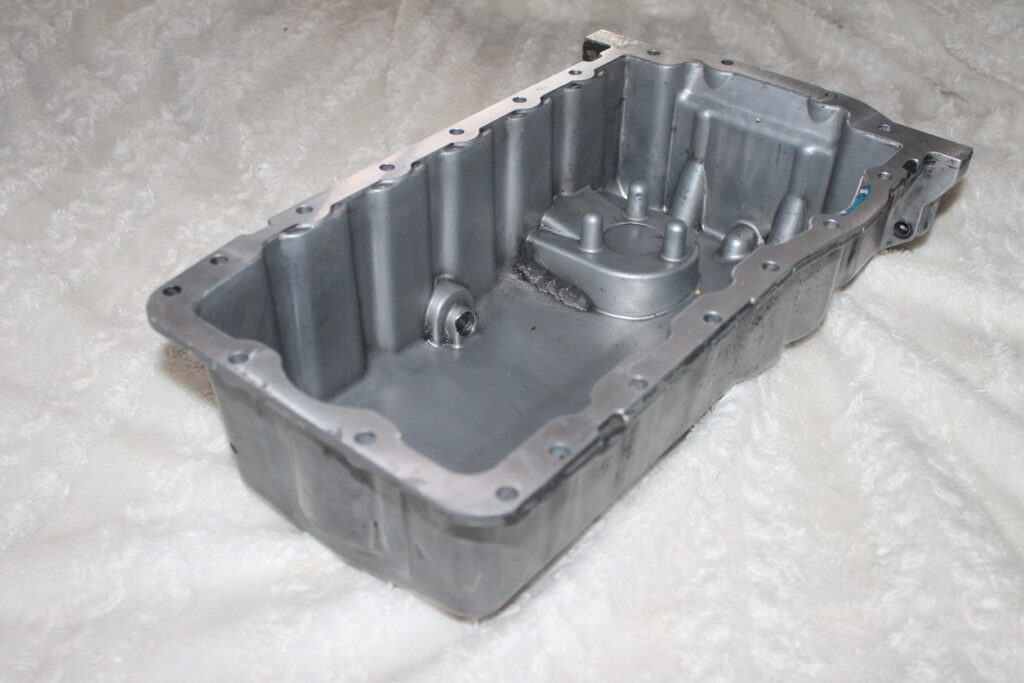Your car’s engine is made of many parts that all work together to keep your vehicle running smoothly, like the piston, valves, engine block, timing belt, and more. When just one of these parts stops running, you can find yourself on the side of the road or stuck in your driveway. In this post, our automotive experts share helpful facts about your engine’s crankcase, a vital but often overlooked part of your car’s engine.
What Is a Crankcase?
A crankcase is like a protective container in the middle of an engine. It holds crucial engine parts like the crankshaft and lubricates them with oil to reduce friction and wear. The crankcase also helps prevent oils from escaping. An integral part of the engine, a crankcase essentially holds all an engine’s components together.
Some of the parts of an engine housed within the crankcase include:
- Oil pan. The oil pan is a large part of the crankcase within a wet sump engine. Here, oil is stored and used to lubricate parts of the engine.
- Crankshaft. Essentially the heart of your engine, the crankshaft works with your engine’s pistons to keep your car’s wheels turning.
- Camshaft. The camshaft helps your engine breathe by controlling the engine flaps, which allow exhaust to escape.
What Is a PCV Valve in a Crankcase?
PCV stands for positive crankcase ventilation. Your crankcase is ventilated primarily through a PCV valve, a one-way valve that keeps exhaust out of your crankcase so it can continue running smoothly. When waste gases enter a crankcase, they can mix with oil to create sludge, which can gum up your engine.
PCV valves periodically need replacing but can become clogged after a while and require replacement. Some signs of a bad PCV valve include a whistling or hissing sound, decreased vehicle performance, increased oil consumption, and an illuminated check engine light. Check out our blog post on your car’s PCV valve for more information!
Types of Crankcases
Many different types of crankcases are used in various engines, dependent upon other vital parts of the engine. There are wet sump crankcases, which use oil to lubricate parts of the engine. Most cars use a wet sump crankcase in a four-stroke engine.
Other Frequently Asked Questions About Crankcases
Since your crankcase is such a vital part of your engine, it should illuminate your check engine light when it needs repair. Some other signs of a damaged crankcase include oil leaks, stalling, difficulty starting, and uncommon noises.
If you suspect your crankcase isn’t working correctly, it’s best to visit a trusted mechanic, like those at Kennedy Transmission, as the crankcase comprises several parts that can sustain damage or stop working. Since your crankcase is such a large part of your engine, removing or repairing it on your own is difficult and potentially dangerous.
No, electric cars do not have a crankcase. This is because an electric car engine does not use pistons or other car parts held by a crankcase. Instead, an electric car uses a battery, traction motor, and inverter.
Because crankcases need to remain light and avoid overheating, they are commonly made of aluminum alloy, which prevents overheating and is more lightweight.
A crankcase pressure sensor monitors the pressure within your engine’s crankcase, helping ensure optimal engine performance and preventing damage caused by excessive pressure or vacuum. It’s an essential component in maintaining efficient operation and prolonging engine life.
Get Professional Car Maintenance From Kennedy Transmission
We know how stressful it can be when your check engine light comes on and you don’t understand why. The automotive experts at Kennedy Transmission Brake & Auto Service are here to help. We’ll get to the bottom of the problems with your car and perform the repairs you need to get you back on the road.
Residents across the city count on our Minneapolis auto repair services thanks to our reliable services and friendly technicians. We offer comprehensive engine repair services, including crankcase maintenance and repair. Visit one of our auto shops in Minneapolis to get started today, or contact us with any questions.

